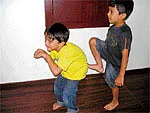

Started by Preeti Sunderajan, a trained Bharata Natyam dancer, Body Talk, for kids between the ages of 3 and 8, works on the principle that children primarily experience the world through their bodies and their sense of self is strongly connected to how comfortable and at ease they are with their bodies.
When children are sent to learn music, dance or drawing at a very young age, they are made to abide by the rules, are given guidelines and made to follow a set pattern. There is no room for experimentation, or for their own creativity to come to the forefront. Parents too want instant results.
This curbs the creativity of children and, at times, leaves them disinterested in their pursuit, says Preeti. At Body Talk, each child is given the freedom to be creative and to explore any sphere of creativity. “We give them the basic texture and layer of the art form and the child just picks it from there,” elaborates Preeti.
Megha Suhas, a child psychologist and a facilitator with Body Talk adds, “There are no techniques taught here and no sense of right or wrong. Children are free to express their thoughts through their bodies and expressions. In this process, they are initiated into being comfortable with their bodies. They start using their bodies freely — to design and craft ideas and use their pent-up energies positively. They use rhythms, emotions and voices and experience freedom in creativity as never before.”
Teaching methodology
Body Talk is a workshop module that nurtures the child’s creative spirit through movement games, rhythm work and improvisation. Using both their bodies and minds to think, the child finds unique ways to create, collaborate and communicate with confidence. Preeti’s Bharata Natyam skills also come into play during these workshops.
She has skillfully infused the essence and strength of classical dance and the creative process of performing arts into this. She applies abhinaya, which helps the child get in touch with his/her feelings, enhances his/her story telling ability, non-verbal communication skills, etc. It also helps in the development of the child’s complex motor skills.
When Preeti demonstrates a basic dance gesture like pataka and asks the children to interpret it in their own way, each child has a different interpretation — from a floor wiper, duster to even a mosquito swatter! Another dance gesture like ta ki ta explores their imagination in rhythm. The little ones are stimulated in the right direction just so that they can unfold their imagination. They develop a sense of rhythm and understand the nuances of music and performing arts like theatre and dance.
Preeti says, “For three-year olds, the first few classes are hand held. Children are introduced to non-verbal communication and prodded lightly to think in a certain direction. Even though freedom in creativity is important, we also make sure that our programme is structured, which further depends on the age group. We work towards extricating a certain outcome from the child. We have a warm-up session where we amalgamate yoga stretches with a basic Bharata Natyam. We believe that a positive and responsive body is the key to self development. The ability to be creative with one’s own body through movement and dance fosters problem-solving skills, develops a strong self image and nurtures a healthy personality.”
Cracking the parent
When parents come to Preeti with the worry and anxiety that their child is not creative and expressive at all, her first step is to correct them and help them understand this: That each child is blessed with a quality which sets him/her apart from the others. Some children take more time to express and open up than the others but eventually they start enjoying and discovering new facets in themselves. Once given the right pathway, the sky is the limit.
Says Bhuvi Kilpady, mother of eight-year-old Om, “My son looks forward to Body Talk classes and enjoys the time he spends there. When he began classes, he was a shy and reticent child but within a few months, I noticed a definite change in him. He grew in confidence, his body language changed, he is now surer of himself and he is open to new ideas. Body Talk classes have instilled a sense of discipline and purpose in him.”
Preethi’s programme has become a part of the curriculum in schools such as First Step and Buddhi. And more such affiliations are in the offing and why not? This programme is for the overall benefit of children.
They become more aware of their inner self and are in control of their bodies. They are focused, disciplined, comfortable in their environment, confident and develop their creativity. Not only does that help children understand their uniqueness but it also helps them appreciate others and their talents.
